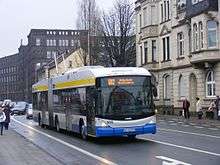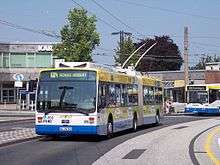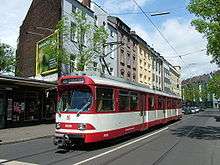Trolleybuses in Solingen
The Solingen trolleybus system (German: Oberleitungsbussystem Solingen), also known locally as the Stangentaxi, serves the city of Solingen, in the federal state of North Rhine-Westphalia, Germany.
| Solingen trolleybus system | |||
|---|---|---|---|
 A Hess trolleybus in Solingen, 2010 | |||
| Operation | |||
| Locale | |||
| Open | 19 June 1952 | ||
| Status | Open | ||
| Routes | 6 | ||
| Operator(s) | Stadtwerke Solingen | ||
| Infrastructure | |||
| Electrification | 600 V DC | ||
| |||
| Website | Stadtwerke Solingen (in German) | ||
Opened on 19 June 1952, it is the largest of the three remaining trolleybus systems in Germany (the others being in Eberswalde and Esslingen am Neckar). The network centres on Graf-Wilhelm-Platz (Count William Square), and one of its lines extends into the neighbouring municipality of Wuppertal.
History
The first trolleybus was brought into service on 19 June 1952. The network was a conversion of the previous tram services. Conversion from tramway was completed on 2 December 1959. Extensions to the system were opened in 1981–82 – Schlagbaum to Hasselstraße (2.6 kilometres (1.6 mi)) and Höhscheid to Brockenberg (0.8 kilometres (0.50 mi)) respectively – and in 1993 from Aufderhöhe to Mangenberg/Graf-Wilhem-Platz (8.2 kilometres (5.1 mi)).
The mid-1990s saw plans to replace the trolleybuses with diesel buses, but this was never pursued; trolleybuses being preferred over diesel vehicles because of superior acceleration and better suitability for the hilly terrain.
Network

As of 2007, 6 lines are in operation. The older lines (681–684) are served every ten minutes, and the newer lines (685–686, opened 22 August 1993) run every half-hour, although they are duplicated by each other for the majority of their route. Routes 681 and 682 interchange with the city's principal railway station – Solingen Hbf – which lies in the western suburbs. Line 683 – at 14.5 kilometres (9.0 mi), by far the network's longest – also connects to the Wuppertal Schwebebahn at Vohwinkel, the northern end of the route and the western terminus of the Schwebebahn. The southern extent of 683 is the town of Burg an der Wupper, which contains Schloss Burg (Burg Castle). Burg is also home to the world's only trolleybus turntable, owing to lack of space to provide a full turning circle. This precludes the use of articulated vehicles like on the rest of the network. Until November 2009 this turntable was in regular use for line 683. Since November 2009 line 683 has been extended to Burger Bahnhof. On the new section, the buses use their diesel engine instead of electricity, as no overhead wires were constructed here.
Fleet
As of early 2007 the fleet stands at 49 vehicles: 15 articulated Berkhof buses (2001/2), 20 articulated Van Hool buses (2002/3), and 14 three-axle MAN buses (1986-7). The latter are due for replacement during 2008. The power supply is 600 V DC.
References
- Kenning, Ludger; Lehmann, Jürgen (2011). Obusse in Deutschland [Trolleybuses in Germany] (in German). Band 2: Nordrhein-Westfalen, Hessen. Nordhorn: Kenning. ISBN 9783933613318.
- Lehmann, Jürgen (2002). Der O-Bus in Solingen [The Trolleybus in Solingen] (in German). Nordhorn: Kenning. ISBN 3933613558.
- Walther, Christian (2002). 50 Jahre Obus in Solingen [Fifty Years of Trolleybuses in Solingen] (in German). Freiburg: EK-Verlag. ISBN 3882558423.
External links
![]()
![]()
- "Trolleybus city : Solingen". Trolleymotion.
- Solingen database / photo gallery and Solingen trolleybus list at Urban Electric Transit – in various languages, including English.


